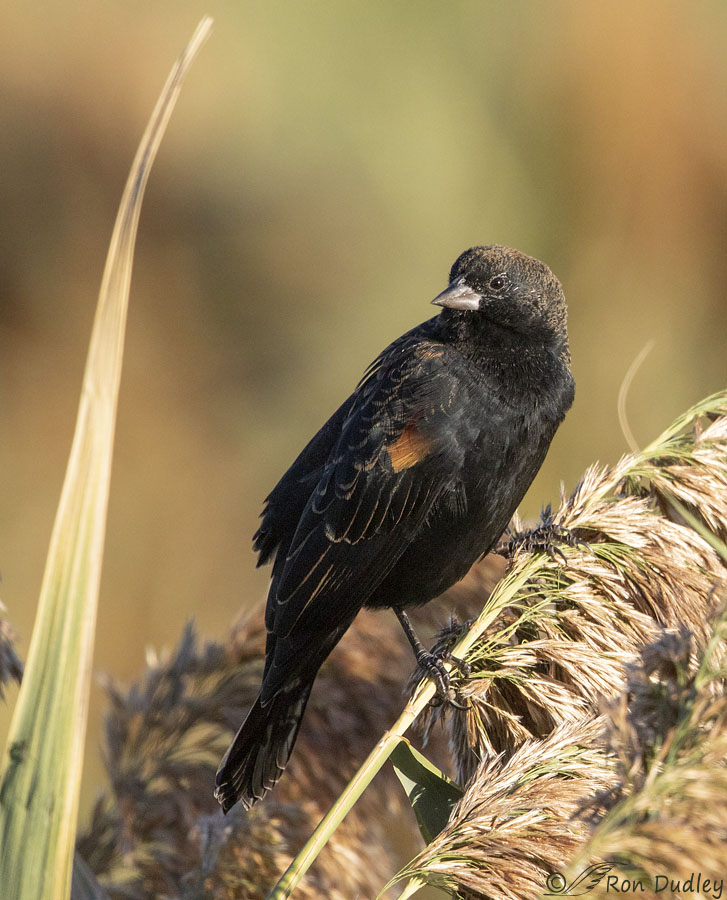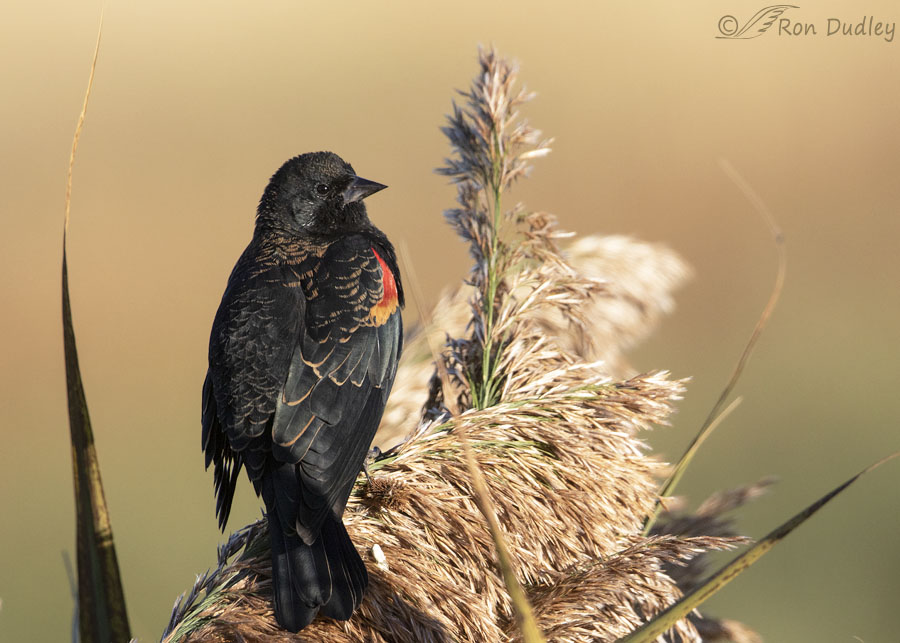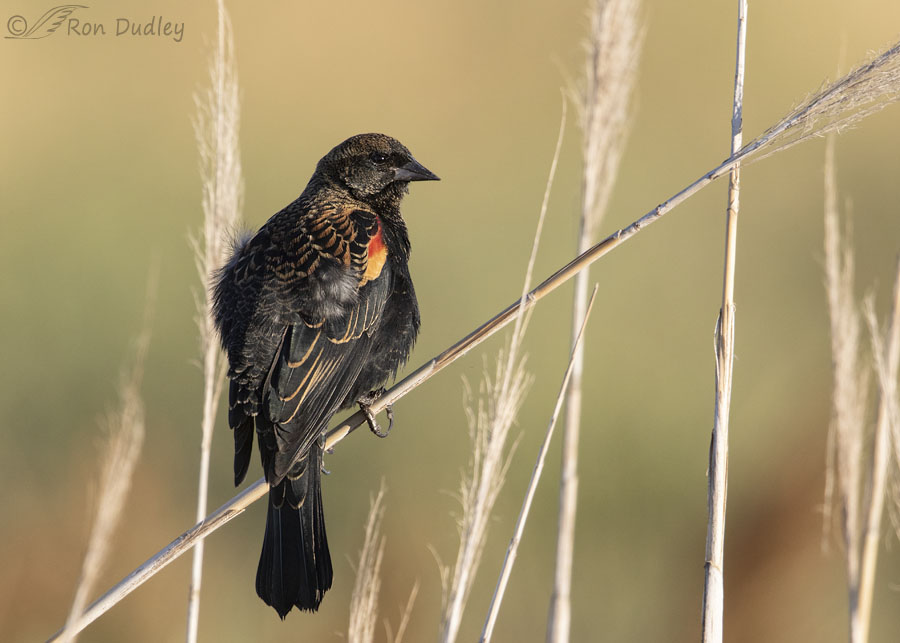Some simple shots of a common species and further evidence that followers of Feathered Photography have big hearts.

1/3200, f/6.3, ISO 800, Canon 7D Mark II, Canon EF 500mm f/4L IS II USM + EF 1.4 III Extender, not baited, set up or called in
Three days ago at Farmington Bay WMA Red-winged Blackbirds were flocked up, feeding on sunflowers and phragmites and seemingly feeling their oats as they boisterously moved from one foraging area to another. This time of year blackbirds are a challenging exposure on phragmites because the dying phrag stalks and plumes are very light colored and the birds are so black but if the sun’s at the right angle to the bird it can be pulled off reasonably well.
In this shot I like the way the bird is framed between the plumed perch and the dying leaf on the left.

1/2500, f/6.3, ISO 800, Canon 7D Mark II, Canon EF 500mm f/4L IS II USM + EF 1.4 III Extender, not baited, set up or called in
The setting here is similar to the first photo but I think the overall effect of the image is quite different, in part because of the horizontal versus vertical crop and the different head turns from the birds.

1/1000, f/6.3, ISO 800, Canon 7D Mark II, Canon EF 500mm f/4L IS II USM + EF 1.4 III Extender, not baited, set up or called in
Many years ago Richard Ditch, one of my early bird photography mentors, taught me to appreciate graphic lines in my bird photos so I immediately thought of him when I saw this shot. I like the contrast of the sharp diagonal perch against the many mostly softer vertical stems behind it. And the blackbird provides an interesting focal point.
We’re on the periphery of the huge blizzard that’s slamming Montana this weekend so it’s been cloudy with intermittent rain and I haven’t been able to go shooting. Hopefully it will begin to clear out this afternoon so there’s a possibility for tomorrow.
In the meantime I hope to get some image culling done. My backlog is huge and intimidating.
On another subject:
A huge thank you to followers of Feathered Photography for making a significant dent in the ambitious goal of the fundraiser for Jerry Liguori. And that’s only the folks on the list whose names I recognize. Since my blog has over 900 subscribers I only recognize the names of those who comment regularly on my blog (or those who mentioned Feathered Photography in their comment when they donated). In addition, many folks donated anonymously and I’m sure that some of those also came from Feathered Photography.
Further evidence that my readers have big hearts. You restore at least part of my faith in humanity and I’m proud to know ya!
Ron


Ron, the sun shows off the brilliant colors of this blackbird. I’ve never seen one. I guess I got blackbirds mixed up with ravens, which I’ve seen in Utah’s national parks. I like the 3rd photo the best with the graphic lines, as you mentioned. It is wonderful that so many people contributed to the Jerry Ligouri fund. I think you have a special group of followers on Feathered Photography. Thank you, Ron
Alice, blackbirds are much smaller than ravens.
Yes, I certainly do.
Common? I wish. On this side of the pond they are absent, and I am so very grateful (as I so often am) for the wonders you bring me each day. Beautiful and a songster is something we rarely see. We do have some incredible birds but they have mostly left the building well before musical abilities were handed out.
I very often enjoy the flavor of your comments, EC – in this case your last sentence.
That said, the song of this species is far from musical in my opinion.
Amen to their song NOT being musical!
Perhaps slightly more “musical” than their cousins, the Yellow-headed Blackbirds but I love ‘em both.
Looking at your photos I think this bird should be renamed the Black-Brown-Red-Yellow-Gray Bird. Once again, you have persuaded me to put my scope on them to see all the hues these images have revealed.
And those hues can vary significantly as Dan said in his comment.
Love the Blackbirds and their song is one of my favorite bird songs. Thanks for the closeup.
Thank you, Betty.
The background colors set this bird off very well and create a very pleasing effect.
I think you are right to be skeptical, I’m quite sure this is not a Tricolored Blackbird. Just based on range alone I think that would be an incredible find. 98-99% of them are in California with a few scattered populations in Washington Oregon and Baja California. Very few reach western Nevada (I believe only in one location) but not further east. Some male Red-winged Blackbirds have a yellow patch below the red and some do not, but I believeD that all male Tricolored Blackbirds will have a white patch below the red. The white of the Tricolored and yellow of the Red-winged may not always show and even the red is frequently covered. Red is a sign of aggression and males show it prominently to defend territory. They often feed together, even during breeding season, and the red is mostly covered then. Watch if two males feeding communally bummp into each other. The red may be suddenly flared to show dominance or willingness to fight. It usually is quickly coved, however, and feeding is resumed.
Thanks, Dan. I see that yellow below the red fairly often.
Very nice photos Ron. Nice contrast with the dark Blackbirds and the light background. I took a photo once of a flock of combined Red-winged and Yellow-headed Blackbirds that had to be somewhere between 70 and 100. I have never taken the time to count them, but I remember it was extraordinary. We have them around our lakes year round and in the winter they split up and we will often see large flocks of just females. I agree with Kathy regarding the first photo. Thanks for sharing these.
We see them in even larger flocks than that, Everett. Sometimes other species join the flocks. Thank you.
This appears to be a tricolored blackbird, Ron. It’s endangered around here. .
I’m skeptical about that, Martha. What do you base it on?
Ron, the final shot shows the right shoulder of the bird with both red and yellow in the epaulet. Here is a link to a similar image. https://avibirds.com/wp-content/uploads/2019/06/tricolored-blackbird-442×353.jpg.
Martha, I often see Red-winged Blackbirds with yellow in their epaulets. Here’s what Birds of North America Online says about Red-winged Blackbirds – “Males in Definitive Basic Plumage are glossy black with epaulets of red bordered with yellow on the wrist (bend) of the wing, though males in some California and Mexico populations lack the yellow border.”
Dan Gleason points out the same thing in his comment.
The bird in the link looks yellow below red. If so, th en it is mislabeled. Tricolored Blackbirds always show white below red.
Oh such beauty! The feather detail is one of those things I don’t get to see, that is, until your brought it to me this morning. Thank you! Red-winged blackbirds might be a common species, but that doesn’t mean we shouldn’t celebrate them every time we see them. And what a lovely song. On every cross-country road trip, I’d sing with them, relishing the happiness they seemingly effortlessly release onto the air!
Again, thank you for bringing those beauties to me this lovely morning! Hope you don’t get snowed in, but it’s gloriously cool here today!
Thank you, Laura. We’re getting snow in the nearby mountains but I think we’ll be ok down in the valleys with this storm.
These are all beautiful. Your photos really accent the colors of the feathers…the definition is terrific, each feather looks lined in beige and the red and yellow shoulder patches are not harsh. Phragmites provides a beautiful component…I would frame the first photo any day…it is special! You are right about the angle of the sun with blackbirds…just a few degrees makes or breaks the photo no matter how everything else lines up. I think that is why I prefer photographing the female of the species…their colors are softer to view.
You are right about the angle of the sun with blackbirds…just a few degrees makes or breaks the photo no matter how everything else lines up. I think that is why I prefer photographing the female of the species…their colors are softer to view.
Thanks, Kathy. This species might be the most difficult exposure of the species I photograph. Without the sun directly behind you and low in the sky you’re nearly always screwed. And even then you often have to get lucky.
Beautiful photos of the red winged blackbird…… A challenge but the phragmites do set them off nicely vs the green cat tails we normally see them in (or mobbing the bird feeder)
A challenge but the phragmites do set them off nicely vs the green cat tails we normally see them in (or mobbing the bird feeder)  Had to tell how much snow is where. Down in our hole by the creek with the warm water and ground being warm we have about 3″ accumulation so far. Guessing up towards the highway there is more and KNOW up top is more – neighbor reported about 4″ as of noon yesterday when he took a drive to the N. News indicates 6 to 8″ in GF. Browning and the Front Range have it in the 2′ plus range. Wind has died for the moment and I’m eyeing the trees with the leaves on sagging heavily (little wind might be helpful with that
Had to tell how much snow is where. Down in our hole by the creek with the warm water and ground being warm we have about 3″ accumulation so far. Guessing up towards the highway there is more and KNOW up top is more – neighbor reported about 4″ as of noon yesterday when he took a drive to the N. News indicates 6 to 8″ in GF. Browning and the Front Range have it in the 2′ plus range. Wind has died for the moment and I’m eyeing the trees with the leaves on sagging heavily (little wind might be helpful with that  and the pickup is away from them) Still snowing. Nowhere to be until Tues. soooooo
and the pickup is away from them) Still snowing. Nowhere to be until Tues. soooooo  Glad your “advertising” has allowed for some help for Jerry – it adds up after awhile……
Glad your “advertising” has allowed for some help for Jerry – it adds up after awhile……
Thank you, Judy. I’m seeing reports of 4′ (that’s feet, not inches) of snow at East Glacier this morning. That’s only 48 miles from Cut Bank. These days I’m too damned old to take that kind of weather, especially in September!
We aren’t amused by this either…… Neighbor opined that we ought to come spend some time in FL with them this winter….
Neighbor opined that we ought to come spend some time in FL with them this winter….  Of course, they have their own issues and, even tho their place is in a less populated region I’m not sure I’d care for it…….
Of course, they have their own issues and, even tho their place is in a less populated region I’m not sure I’d care for it…….
Just heard from my cousin Jim who still lives on the farm. The wind is piling up huge drifts and they have to drive to Kalispell on Wednesday (through East Glacier of course) to get his wife’s knee injury repaired (torn meniscus). Just getting from the farm on the dirt road to the pavement could be dicey, not to mention the other 130 miles to get to Kalispell.
NOT fun for sure! Hope they can get plowed out before then……. Suspect “up top” there are also drifts but haven’t seen any plows yet today……. Weather cooperating a bit here – still snowing but it’s 35 and power lines are cleared of snow and leaves “working on it”.
Hope they can get plowed out before then……. Suspect “up top” there are also drifts but haven’t seen any plows yet today……. Weather cooperating a bit here – still snowing but it’s 35 and power lines are cleared of snow and leaves “working on it”.